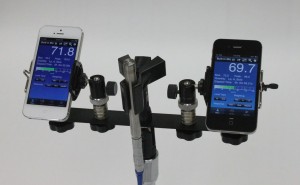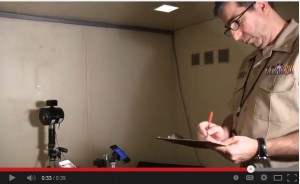So How Accurate Are These Smartphone Sound Measurement Apps?
Posted on by
As of June 2013, 60% of all mobile subscribers use smartphones—that’s more than 140 million devices. Apple iOS and Google Android platforms account for 93% of those devices [Nielsen, 2013]. Smartphone developers now offer many sound measurement applications (apps) using the devices’ built-in microphone (or through an external microphone for more sophisticated applications). The use of smartphone sound measurement apps can have a tremendous and far-reaching impact in the areas of noise research and noise control in the workplace as every smartphone can be potentially turned into a dosimeter or a sound level meter [Maisonneuve et al., 2010; Williams and Sukara, 2013]. However, in order for smartphone apps to gain acceptance in the occupational environment, the apps must meet certain minimal criteria for functionality, accuracy, and relevancy to the users in general and the worker in particular.

NIOSH noise researchers received numerous requests from stakeholders, safety professionals, and the public to address the accuracy of the many sound measurement applications available for smartphones and whether they can be relied upon to provide an accurate assessment of the ambient environment. As a result, we conducted a pilot study to select and characterize the functionality and accuracy of these apps as an initial step in a broader effort to determine whether these apps can be relied on to conduct participatory noise monitoring studies in the workplace [Kardous and Shaw, 2014]. The resulting paper, Evaluation of smartphone sound measurement application, was published in the Journal of the Acoustical Society of America.
We selected and acquired a representative sample of the popular smartphones and tablets on the market as of June 2013. Smartphone apps were selected based on their ability to measure occupationally relevant sound level values. A total of 130 iOS apps were examined and downloaded from the iTunes store*, of those, 10 apps met our selection criteria. A total of 62 Android apps were examined and downloaded, however, only 4 apps partially met our criteria and were selected for additional testing. As a result, a comprehensive experimental design and analysis similar to the iOS devices and apps study above was not possible.
The measurements were conducted in a diffuse sound field at a reverberant noise chamber at the NIOSH acoustics testing laboratory. For our experimental setup, we generated pink noise with a 20Hz ‒ 20kHz frequency range, at levels from 65 dB to 95 dB in 5-dB increments (7 different noise levels. Reference sound level measurements were obtained using a ½-inch Larson-Davis (DePew, NY) model 2559 random incidence microphone. Additionally, a Larson-Davis Model 831 type 1 sound level meter was used to verify sound pressure levels. Smartphones were set up on a stand in the middle of the chamber at a height of 4 feet and approximately 6 inches from the reference microphone as shown in Figure 1.

Overall, the results in Figure 2 show that for A-weighted sound level measurements three apps had mean differences within ± 2dBA of the reference measurements. For un-weighted sound level measurements three apps had mean differences within the ± 2 dB of the reference measurement. Since national standards and occupational guidelines specify that type 2 sound measurement instruments have an accuracy of ± 2dBA, some of the above-mentioned apps could potentially be used in the occupational setting, especially if they’re used in conjunction with a type 2 external microphone such as the MicW i436.
Android-based apps lacked the features and functionalities found in iOS apps. This is likely due to the iOS advanced audio capabilities compared to other platforms, the open ecosystem of the Android platform, and having so many different Android device manufacturers using different suppliers and components.
Challenges remain with using smartphones to collect and document noise exposure data. Some of the main issues encountered in recent studies relate to privacy and collection of personal data, sustained motivation to participate in such studies, bad or corrupted data, and mechanisms for storing and accessing such data. Most of these issues are being carefully studied and addressed [Drosatos et al., 2012; Huang et al. 2010].
In conclusion, smartphone sound apps can serve to empower workers and help them make educated decisions about their work environments. They may be useful for industrial hygienists and OS&H managers to make quick spot measurements to determine if noise levels exist in a workplace that can harm workers’ hearing. The ubiquity of smartphones and the availability of these sound measurement apps may also present new research opportunities for occupational hearing scientists and researchers.
November 2016 Update: NIOSH researchers have just published a follow-up study: Evaluation of smartphone sound measurement applications (apps) using external microphones to examine the performance of sound measurement apps using external microphones. The study showed sound level measurements to be within ±1 dB of the reference system using the same test setup and apps from the initial study. This follow-up study suggests that using external, calibrated, microphones greatly improves the overall accuracy and precision of smartphone sound measurements, and removes much of the variability and limitations associated with the built-in smartphone microphones.
June 2018 Update: EA LAB and NIOSH researchers have evaluated the app’s performance as part of a system (iPhone + external microphone) for compliance with type 2 requirements of IEC 61672/ANSI S1.4 standard: Sound Level Meters – Part 3: Periodic Tests. The results were published in the Applied Acoustics Journal [Celestina et al. 2018].
Celestina, M., Hrovat, J., & Kardous, C. A. (2018). Smartphone-based sound level measurement apps: Evaluation of compliance with international sound level meter standards. Applied Acoustics, 139, 119-128. https://doi.org/10.1016/j.apacoust.2018.04.011
Chucri A. Kardous, MS, PE and Peter B. Shaw, Ph.D.
CAPT Kardous is a research engineer in the NIOSH Division of Applied Research and Technology.
Dr. Shaw is a statistician in the NIOSH Division of Applied Research and Technology.
*References to products, services, or apps do not constitute an endorsement by NIOSH or the U.S. government.
References
Drosatos, G., Efraimidis, P. S., Athanasiadis, I. N., D’Hondt, E., & Stevens, M. [2012]. A privacy-preserving cloud computing system for creating participatory noise maps. In Computer Software and Applications Conference (COMPSAC), 2012 IEEE 36th Annual (pp. 581-586). IEEE.
Huang, K. L., Kanhere, S. S., & Hu, W. [2010]. Are you contributing trustworthy data? the case for a reputation system in participatory sensing. In Proceedings of the 13th ACM international conference on Modeling, analysis, and simulation of wireless and mobile systems (pp. 14-22). ACM.
Kardous, C. A., & Shaw, P. B. (2014). Evaluation of smartphone sound measurement applications. The Journal of the Acoustical Society of America, 135(4), EL186-EL192; http://dx.doi.org/10.1121/1.4865269
Kardous, C. A., & Shaw, P. B. (2016). Evaluation of smartphone sound measurement applications using external microphones – A follow-up study. J. Acoust. Soc. Am. 140, EL327 (2016); http://dx.doi.org/10.1121/1.4964639
Maisonneuve N., Matthias N. [2010]. Participatory noise pollution monitoring using mobile phones. Information Polity, 51-71.
Nielsen [2013]. Mobile Majority: U.S. Smartphone ownership tops 60%. Retrieved June 23, 2013, from http://www.nielsen.com/us/en/newswire/2013/mobile-majority–u-s–smartphone-ownership-tops-60-.html
Williams W. and Sukara Z. [2013]. Simplified noise labelling for plant or equipment used in workplaces. Journal of Health and Safety, Research and Practice, Vol. 5 (2), 18-22.
Posted on by

